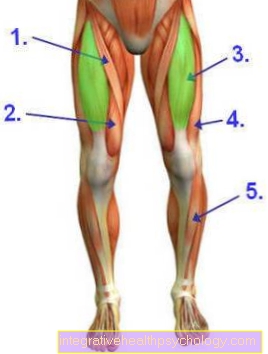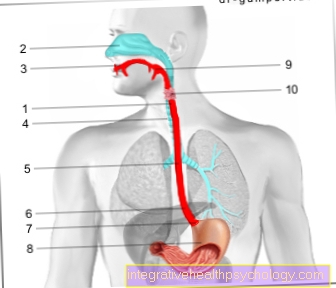This is how a frozen shoulder is treated
introduction
Frozen shoulder is one of the degenerative changes in the shoulder joint.
The joint is restricted in its mobility due to inflammation and a shrinkage of the joint capsule.
Below you will find a list and explanation of numerous treatment options.
General information about frozen shoulder can be found at: Frozen shoulder - everything you should know

These are the treatment options
There are numerous ways to treat frozen shoulder.
However, it may take some time for it to heal completely.
The most suitable treatment also depends on the stage of the disease.
-
Pain therapy takes place with so-called non-steroidal anti-inflammatory drugs (NSAIDs) such as ibuprofen and diclofenac.
These can be taken as tablets or applied directly to the shoulder as a gel or cream. -
Cortisone therapy as an injection or in tablet form is used to relieve pain and improve mobility in the shoulder joint.
-
Another option for treating pain is what is known as a nerve block.
To do this, the nerves that cause the pain in the shoulder are numbed using local anesthetics. -
The mobility in the shoulder joint is improved by stretching exercises.
These should initially be carried out as part of physiotherapy and later also by the person concerned alone. -
Alternative but unproven helpful treatment options include acupuncture, laser therapy, magnetic field therapy, and homeopathy.
-
If the symptoms are not improved by conservative measures, an operation can help to improve the shoulder discomfort.
The operation is usually carried out by means of an arthroscopy.
Read the following article about the symptoms that can be used to recognize a frozen shoulder: You can tell when you have frozen shoulder by these symptoms
Cortisone shock therapy (oral)
Cortisone shock therapy is used for frozen shoulder to relieve pain and improve mobility.
For this purpose, cortisone is taken in tablet form for about 3 weeks.
The dose of cortisone is initially high and then gradually decreased.
Cortisone tablets do relieve the symptoms, but are not suitable for long-term therapy, as side effects such as osteoporosis can occur.
It is also important that the cortisone tablets are not discontinued independently, but rather slowly tapered, as this can also lead to severe side effects in the hormonal balance.
Appointment with a shoulder specialist

I would be happy to advise you!
Who am I?
My name is Carmen Heinz. I am a specialist in orthopedics and trauma surgery in the specialist team of .
The shoulder joint is one of the most complicated joints in the human body.
The treatment of the shoulder (rotator cuff, impingement syndrome, calcified shoulder (tendinosis calcarea, biceps tendon, etc.) therefore requires a lot of experience.
I treat a wide variety of shoulder diseases in a conservative way.
The aim of any therapy is treatment with full recovery without surgery.
Which therapy achieves the best results in the long term can only be determined after looking at all of the information (Examination, X-ray, ultrasound, MRI, etc.) be assessed.
You can find me in:
- - your orthopedic surgeon
14
Directly to the online appointment arrangement
Unfortunately, it is currently only possible to make an appointment with private health insurers. I hope for your understanding!
You can find more information about myself at Carmen Heinz.
Cortisone injection
The cortisone injection is given directly into the joint and therefore acts directly on the shoulder joint.
The pain can be alleviated and mobility improved.
However, it should also be noted that there may be side effects.
A cortisone syringe should not be used too often because, in addition to the anti-inflammatory component, repeated use can lead to tissue shrinkage (atrophy).
Furthermore, there is always the risk of infection with a puncture.
Whether tablets or syringes are suitable should be discussed with the attending physician with regard to the advantages and disadvantages of the therapies.
Further information on the effects and side effects can be found under our topic: Cortisone injection
Anti-inflammatory drugs
Anti-inflammatory drugs are so-called NSAIDs or non-steroidal anti-inflammatory drugs.
These pain relievers include ibuprofen and diclofenac, among others.
They are used to relieve the pain that occurs in the first and second phases of frozen shoulder.
Care should be taken to ensure that the painkillers are taken early and then regularly in order to achieve the desired effect.
Since the NSAIDs also attack the gastric mucosa, a gastric protection should also be taken prophylactically while they are being taken.
Proton pump inhibitors such as pantoprazole are suitable for this.
NSAIDs can also be applied directly to the affected shoulder as a gel or cream.
physical therapy
Physiotherapy is primarily used to promote mobility during the stiff shoulder.
The movement in the shoulder is only carried out by the physiotherapist, so the patient does not actively move the shoulder.
Physiotherapy gradually improves mobility in the shoulder.
Physiotherapy can take several weeks to achieve complete freedom of movement in the shoulder joint.
Stretching exercises
Stretching exercises are an important part of the therapy for frozen shoulder.
There are various exercises that those affected can do independently as part of physiotherapy.
The stretching exercises serve on the one hand to increase the mobility in the joint.
On the other hand, they counteract a loss of muscles through immobilization.
Care should be taken when performing the exercises that there is no pain during the stretching.
Which exercises are suitable and how to perform them correctly should be discussed during physiotherapy.
When do you need an operation?
An operation is necessary if the stiff shoulder does not improve with conservative therapy or if pain cannot be adequately contained even with therapy.
It is important to do physiotherapy after an operation in order to maintain the mobility in the shoulder joint achieved by the operation.
Even after an operation, limited range of motion and pain can still occur.
This is done in the operating room
During the operation, the joint capsule, which is stiffened and thus restricts the mobility of the shoulder, is loosened and widened.
In addition to manipulation under anesthesia (MUA), an arthroscopy is often performed.
With MUA, the patient is anesthetized, so the muscles in the shoulder are relaxed.
The doctor then moves the shoulder in all directions to expand and loosen the joint capsule.
In the case of a joint endoscopy, instruments are inserted directly into the joint capsule through small skin incisions.
These instruments are used to cut small parts of the joint capsule to expand the capsule and increase the range of motion in the shoulder.
Often, manipulation and artoscopy are combined.
What can i do on my own?
In order to recover, it is important that those affected cooperate.
For one, it is important to take regular pain relievers.
On the other hand, the stretching exercises discussed should also be performed independently several times a day in addition to physiotherapy.
In the acute pain phase, the shoulder should also be spared and the load should be kept to a minimum.
In addition, cooling the shoulder in the early stages can provide relief.
If the shoulder is stiff, heat therapy can be carried out independently by those affected.
This also helps to loosen the muscles, increase the range of motion and relieve pain.





























